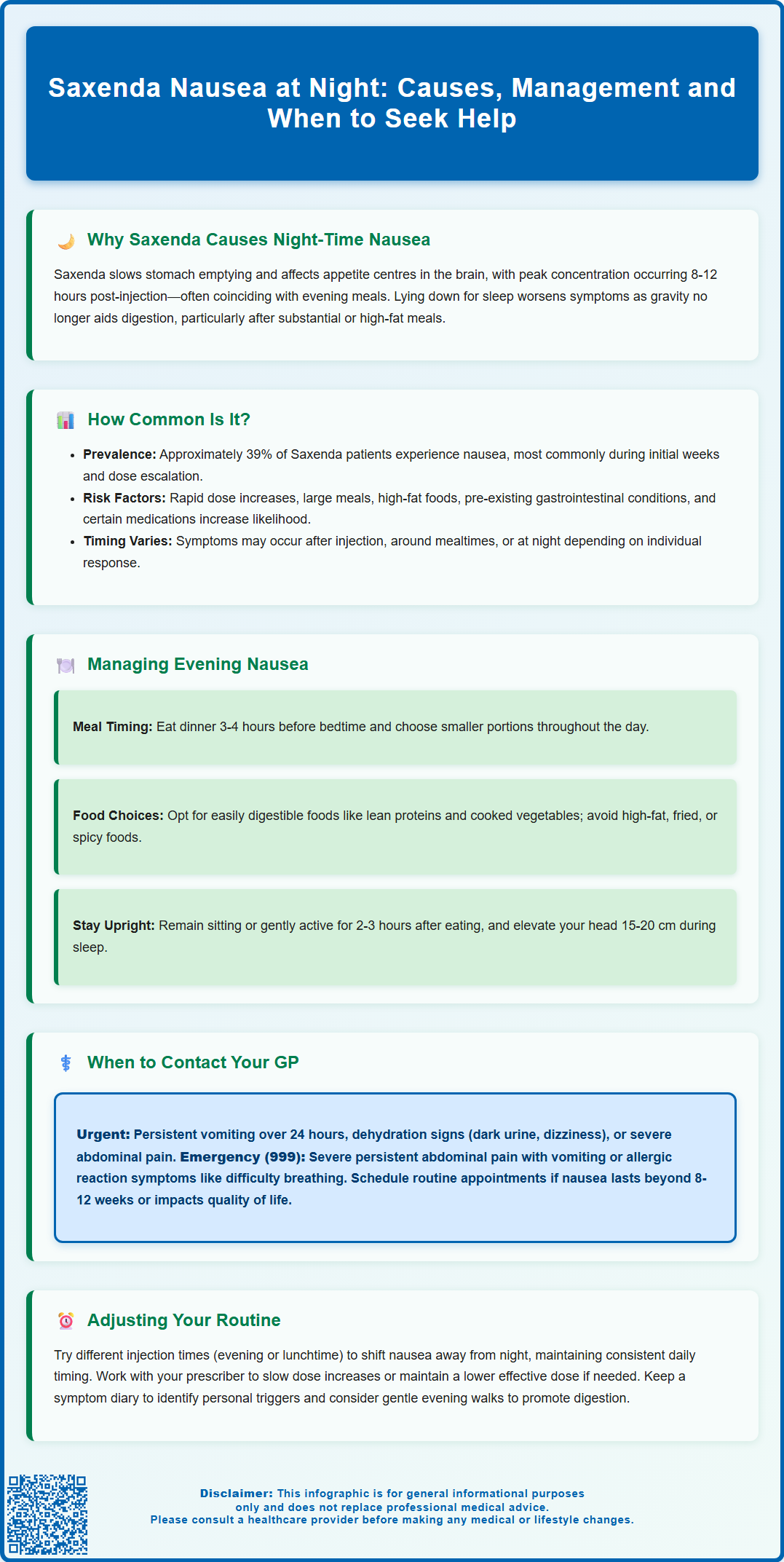Wegovy®
A weekly GLP-1 treatment proven to reduce hunger and support meaningful, long-term fat loss.
- ~16.9% average body weight loss
- Boosts metabolic & cardiovascular health
- Proven, long-established safety profile
- Weekly injection, easy to use

Saxenda (liraglutide) is a GLP-1 receptor agonist licensed for weight management in adults with obesity or overweight with comorbidities. Nausea is the most frequently reported side effect, affecting approximately 39% of patients during clinical trials. Many people find that nausea worsens at night, particularly after evening meals and when lying down. This occurs because Saxenda slows gastric emptying, meaning food remains in the stomach longer, and the medication's peak effects may coincide with bedtime. Understanding why night-time nausea happens and how to manage it effectively can help you continue treatment whilst minimising discomfort and maintaining quality of life.
Summary: Saxenda-related nausea at night occurs because the medication slows gastric emptying, causing food to remain in the stomach longer, with symptoms often worsening when lying down after evening meals.
Saxenda (liraglutide) is a glucagon-like peptide-1 (GLP-1) receptor agonist licensed by the MHRA for weight management in adults with obesity or overweight with weight-related comorbidities. The medication works by mimicking the action of naturally occurring GLP-1, which slows gastric emptying, reduces appetite, and helps regulate blood glucose levels. This delayed gastric emptying, alongside central effects on the brain, contributes to nausea, one of the most frequently reported adverse effects.
Night-time nausea with Saxenda often relates to the timing of your evening meal and the medication's pharmacological action. When you inject Saxenda, it remains active in your system for approximately 24 hours, with peak plasma concentration occurring around 8–12 hours after injection. If you consume a substantial evening meal, the food may remain in your stomach longer than usual, and lying down for sleep may worsen feelings of fullness and nausea, as gravity no longer assists with digestion.
If you administer Saxenda in the morning or early afternoon, its effects may be most pronounced during evening hours, coinciding with your evening meal and bedtime. Individual variation in gastric sensitivity, meal composition (particularly high-fat foods which delay emptying further), and the dose escalation schedule all influence the severity of night-time nausea. Understanding these mechanisms can help you and your healthcare team develop strategies to minimise discomfort whilst maintaining treatment efficacy.

Nausea is the most commonly reported adverse effect of Saxenda, affecting approximately 39% of patients during clinical trials, though the specific incidence of night-time nausea has not been separately quantified in licensing studies. The overall frequency of nausea is classified as 'very common' (affecting more than 1 in 10 people) in the Summary of Product Characteristics approved by the EMA and MHRA.
Most patients experience nausea during the initial weeks of treatment, particularly during dose escalation. Saxenda is initiated at 0.6 mg daily and gradually increased by 0.6 mg increments weekly until reaching the maintenance dose of 3.0 mg daily. This titration schedule is specifically designed to improve gastrointestinal tolerability. Nausea often occurs early during dose escalation and tends to decline over time as your body adapts to the medication, though some individuals continue to experience symptoms throughout treatment.
The timing of nausea varies considerably between patients. Whilst some people report symptoms shortly after injection, others notice discomfort primarily around mealtimes or during the evening and night. There is no official link establishing that night-time nausea is more severe or common than daytime symptoms, but patient reports suggest that lying down after eating can intensify the sensation.
Certain factors may increase your likelihood of experiencing troublesome nausea, including rapid dose escalation, large meal portions, high-fat foods, pre-existing gastrointestinal conditions, and concurrent medications that affect gastric motility. If you have a history of gastroparesis or severe gastrointestinal disease, your prescriber should carefully consider whether Saxenda is appropriate for you.
Effective management of night-time nausea requires a combination of dietary modifications, timing adjustments, and practical strategies that work with Saxenda's mechanism of action rather than against it.
Dietary modifications form the cornerstone of nausea management:
Reduce evening portion sizes: Consume smaller, more frequent meals throughout the day rather than one large evening meal
Eat dinner earlier: Allow at least 3–4 hours between your last meal and bedtime to permit partial gastric emptying before lying down
Choose easily digestible foods: Opt for lean proteins, cooked vegetables, and complex carbohydrates whilst limiting high-fat, spicy, or heavily seasoned dishes that delay gastric emptying
Avoid trigger foods: Identify and eliminate personal triggers, which commonly include fried foods, rich sauces, carbonated beverages, and alcohol
Stay hydrated: Sip water throughout the day, but avoid drinking large volumes with meals or immediately before bed
Practical evening strategies can significantly reduce discomfort:
Remain upright after eating: Sit or engage in gentle activity for 2–3 hours post-meal rather than reclining on the sofa
Elevate your head during sleep: Use additional pillows or raise the head of your bed by 15–20 cm to reduce nocturnal reflux and nausea
Consider ginger: Some patients find ginger tea or supplements helpful, though evidence for their efficacy with GLP-1-related nausea is limited. Discuss any supplements with your pharmacist or GP first
Avoid strong odours: Cooking smells and perfumes can trigger or worsen nausea in sensitive individuals
If nausea remains problematic despite these measures, discuss with your GP whether temporarily pausing dose escalation or, in severe cases, reducing your current dose might be appropriate. The MHRA-approved prescribing information allows for flexibility in titration speed based on individual tolerability.
Whilst nausea is an expected side effect of Saxenda, certain symptoms warrant prompt medical attention. You should contact your GP or healthcare provider urgently if you experience:
Persistent vomiting that prevents you from keeping down food or fluids for more than 24 hours, as this increases the risk of dehydration and electrolyte imbalance
Signs of dehydration: including dark urine, dizziness, reduced urination, dry mouth, or feeling faint when standing
Severe abdominal pain, particularly if constant, radiating to your back, or accompanied by fever, which could indicate pancreatitis (a rare but serious adverse effect)
Inability to tolerate the medication despite dose reduction and dietary modifications
Symptoms of gallbladder disease: such as pain in the upper right abdomen, yellowing of skin or eyes, or pale stools
You should also arrange a routine appointment with your prescriber if:
Nausea persists beyond 8–12 weeks without improvement
You experience significant weight loss beyond your target (more than 1.5 kg per week consistently)
Side effects are affecting your quality of life or ability to maintain adequate nutrition
You develop new symptoms or your nausea pattern changes significantly
You have not lost at least 5% of your initial body weight after 12 weeks on the full 3.0 mg dose (as treatment should be discontinued in this case)
Seek immediate medical attention (call 999 or attend A&E) if you develop:
Severe, persistent abdominal pain with vomiting
Signs of an allergic reaction: difficulty breathing, swelling of face or throat, or widespread rash
Arrange an urgent GP appointment or contact NHS 111 if you notice symptoms of thyroid tumours such as a lump in the neck, hoarseness, or difficulty swallowing (extremely rare but requires investigation).
You can report any suspected side effects to the MHRA Yellow Card Scheme at yellowcard.mhra.gov.uk or via the Yellow Card app.
NICE guidance on obesity management emphasises the importance of regular monitoring during pharmacological treatment. Your prescriber should review your progress, tolerability, and weight loss at appropriate intervals, with a key assessment at 12 weeks on the full 3.0 mg dose.
Strategic adjustment of your Saxenda administration routine can significantly impact the timing and severity of nausea, allowing you to optimise treatment whilst minimising evening discomfort.
Injection timing considerations: According to the Saxenda SmPC, the medication can be administered at any time of day, with or without meals, providing flexibility to find your optimal schedule. If you currently inject in the morning and experience pronounced evening nausea, consider these alternatives:
Evening injection: Administering Saxenda before bed may shift peak effects to daytime hours when you're upright and active, potentially reducing night-time symptoms. However, some patients find this worsens morning nausea.
Lunchtime injection: A midday schedule may provide a balance, with peak effects occurring during afternoon and early evening when you can manage symptoms more actively.
Consistent timing: Once you identify a suitable time, maintain it daily. Saxenda works best with regular administration at approximately the same time each day.
Dose optimisation strategies: Work with your prescriber to find the lowest effective dose that achieves weight loss whilst maintaining tolerability:
Slower titration: If nausea is problematic during escalation, remain at your current dose for an additional week before increasing
Maintenance at sub-maximal dose: Some patients achieve satisfactory weight loss at 1.8 mg or 2.4 mg daily rather than the full 3.0 mg maintenance dose, though this should be a clinician-led decision based on your response and tolerability
Temporary dose reduction: If severe nausea develops, your GP may recommend reducing by 0.6 mg for several days before re-escalating
If you have type 2 diabetes and take insulin or sulfonylureas, discuss with your healthcare provider before changing your Saxenda timing or dose, as adjustments to your diabetes medications may be needed to reduce hypoglycaemia risk.
Complementary lifestyle adjustments enhance overall tolerability:
Keep a symptom diary to identify patterns linking injection timing, meals, and nausea severity
Engage in gentle evening walks after dinner to promote digestion
Practice stress-reduction techniques, as anxiety can exacerbate gastrointestinal symptoms
Ensure adequate sleep, as fatigue may worsen nausea perception
Remember that Saxenda is most effective as part of a comprehensive weight management programme including dietary modification and increased physical activity, as recommended by NICE guidance. Your healthcare team can provide additional support through dietetic services or weight management programmes available through the NHS.
Saxenda slows gastric emptying, meaning evening meals remain in your stomach longer. Lying down after eating worsens nausea because gravity no longer assists digestion, and the medication's peak effects may coincide with bedtime depending on when you inject.
Most patients experience nausea during the initial weeks of treatment, particularly during dose escalation. Symptoms often decline over time as your body adapts, though some individuals continue to experience nausea throughout treatment.
Yes, Saxenda can be administered at any time of day. If you currently inject in the morning and experience evening nausea, consider switching to lunchtime or evening injection to shift peak effects away from bedtime, maintaining consistent daily timing once you find what works best.
The health-related content published on this site is based on credible scientific sources and is periodically reviewed to ensure accuracy and relevance. Although we aim to reflect the most current medical knowledge, the material is meant for general education and awareness only.
The information on this site is not a substitute for professional medical advice. For any health concerns, please speak with a qualified medical professional. By using this information, you acknowledge responsibility for any decisions made and understand we are not liable for any consequences that may result.
Lorem ipsum dolor sit amet, consectetur adipiscing elit, sed do eiusmod tempor incididunt ut labore et dolore magna aliqua. Ut enim ad minim veniam, quis nostrud exercitation ullamco laboris nisi ut aliquip ex ea commodo consequat. Duis aute irure dolor in reprehenderit in voluptate velit esse cillum dolore eu fugiat nulla pariatur.
Block quote
Ordered list
Unordered list
Bold text
Emphasis
Superscript
Subscript